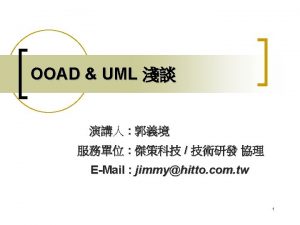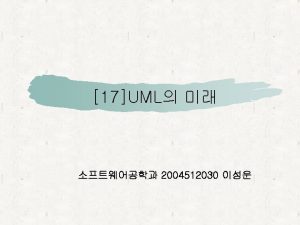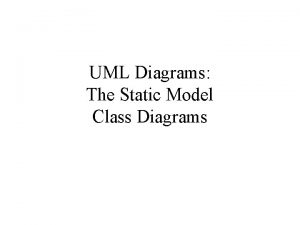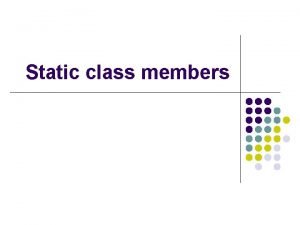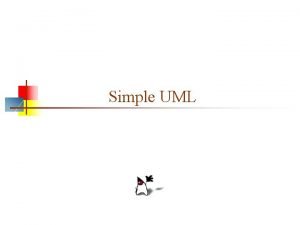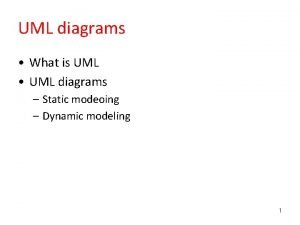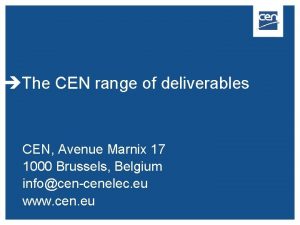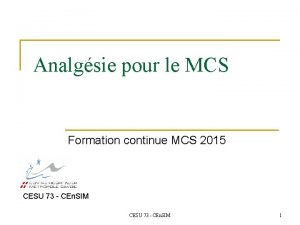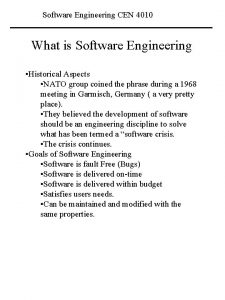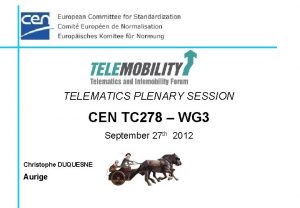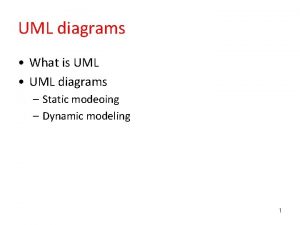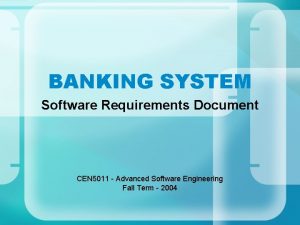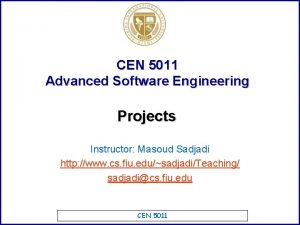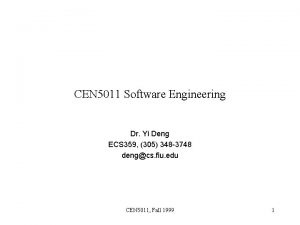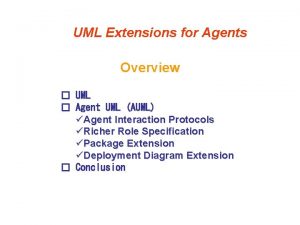UML Overview CEN 5011 Fall 1999 1 Static

















- Slides: 17

UML Overview CEN 5011, Fall 1999 1

Static (Class) View CEN 5011, Fall 1999 2

Use Case View CEN 5011, Fall 1999 3

Interaction View • Sequence diagram – Shows message sequence arranged in time sequence – Can be used to show a scenario - individual history of a transaction – One use is to show the behavior of a use case • Collaboration Diagram – Models and links that are meaningful within an interaction – One use is to show the implementation of an operation – Shows parameters and local variables of the operation • Sequence diagram emphasizes time sequence, relationship among roles implicit • Collaboration diagram emphasizes relationship among roles, time sequence implicit CEN 5011, Fall 1999 4

Sequence Diagram CEN 5011, Fall 1999 5

Collaboration Diagram CEN 5011, Fall 1999 6

State Machine View • Models possible life history of an object of a class CEN 5011, Fall 1999 7

Activity View • A variant of a state machine showing the computational activities • An activity state represents an activity, a workflow step or execution of an operation • Models real-world workflow of an organization or software activities • Helpful in understanding high-level execution behavior without involving internal details of message passing CEN 5011, Fall 1999 8

Activity Diagram CEN 5011, Fall 1999 9

Physical View • Models implementation structure of an application, e. g. its organization into components and its deployment onto runtime nodes • Two physical views: implementation view and deployment view • Implementation view: models components (software units) in a system, as well as dependencies among the components • Deployment view: represents the arrangement of runtime component instances on node instances – Descriptor level view - shows kinds of nodes in the system and kinds of components they hold – Instance level view - shows individual nodes and their links in a particular version of the system CEN 5011, Fall 1999 10

Component Diagram CEN 5011, Fall 1999 11

Descriptor Level Deployment Diagram CEN 5011, Fall 1999 12

Instance Level Deployment Diagram CEN 5011, Fall 1999 13

Model Management View • Models the organization of the model itself – A model comprises a set of packages that hold model elements, such as classes, state machines, use cases, etc. • Packages may be hierarchical formed • Packages are units for manipulating the contents of a model, as well as for access control and configuration control • A model is a complete description of a system at a given level of abstraction from one viewpoint – e. g. analysis model, design model – A model, as well as a subsystem, is a special kind of package CEN 5011, Fall 1999 14

Packages CEN 5011, Fall 1999 15

Extensibility Constructs • Constraints - a textual statement of a semantic relationship expressed in some formal language or in natural language • Stereotype - a new kind of model element designed/utilized by the modeler and based on an existing kind of model element • Tagged value - a named piece of information attached to any model element CEN 5011, Fall 1999 16

Examples of Extensibility Constructs CEN 5011, Fall 1999 17
 Uml overview
Uml overview In uml is a connection among things
In uml is a connection among things Interaction overview diagram
Interaction overview diagram Uml 2
Uml 2 Static class diagram
Static class diagram Eclipse papyrus
Eclipse papyrus Uml static method
Uml static method Uml full form
Uml full form Uml
Uml Aggregation vs composition
Aggregation vs composition Static and dynamic uml diagrams
Static and dynamic uml diagrams Sck cen academy
Sck cen academy Asociace realitních kanceláří cenová mapa
Asociace realitních kanceláří cenová mapa Cenavenue
Cenavenue Modale
Modale Strategia cen prestiżowych
Strategia cen prestiżowych Cen 4010
Cen 4010 Cen tc 278
Cen tc 278


